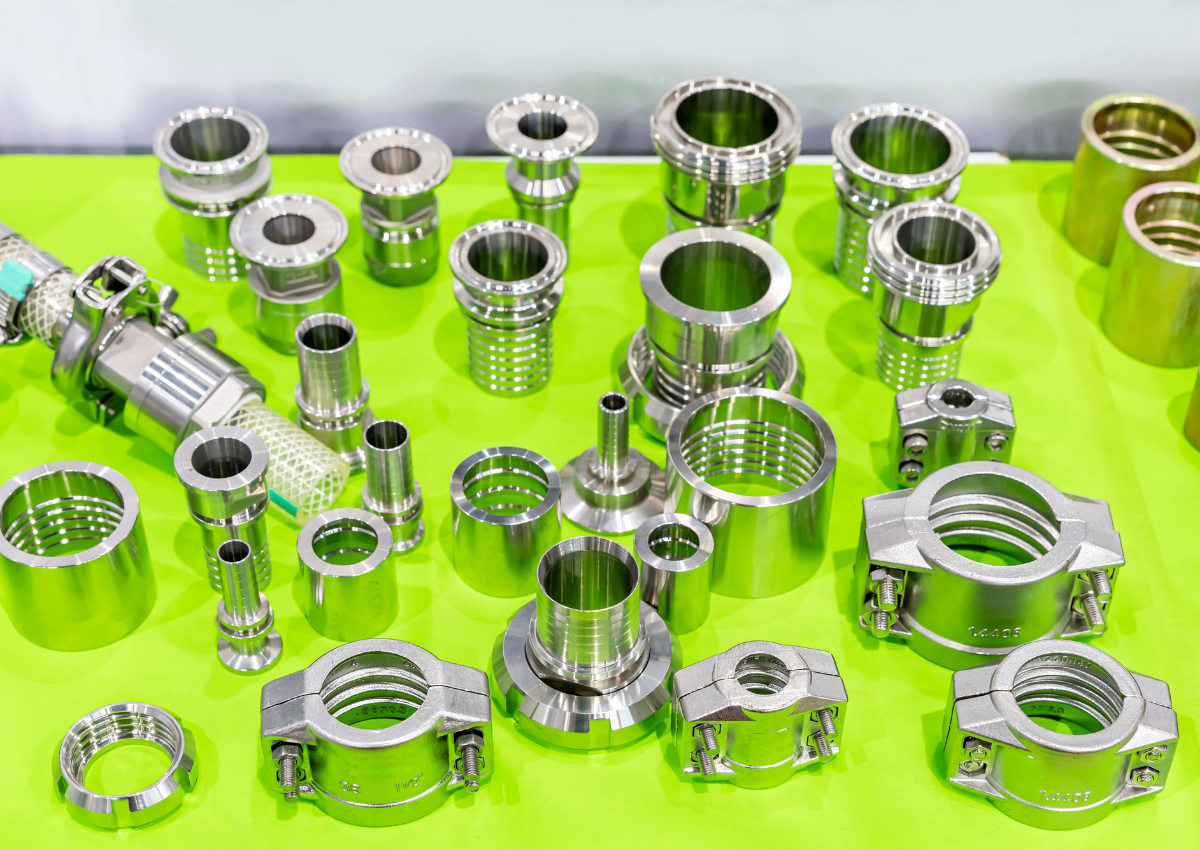In industrial fluid processes, filtration devices fulfill multiple crucial roles such as protecting equipment from damage, improving fluid quality, and keeping piping systems clean. Large scale processes typically employ fixed filtration equipment and permanent piping circuits, but at smaller scales, piping circuit and filtration flexibility is the name of the game. In particular, strainer and filter housings are routinely switched between different piping circuits in order to provide product filtration where it’s needed most, which is made possible by quick-disconnect piping connections. One style of quick-disconnect pipe connections is by far the preferred choice across most fluid process industries: cam and groove couplings, otherwise known as camlock fittings.
In this article, we’ll run through a quick overview of camlock fittings and their most common applications, and then focus specifically on how to select between the two predominant materials used in filtration connections – aluminum and polypropylene.
Camlock Fittings – An Overview
 Camlock fittings consist of separate male and female ends which can be interlocked to form a robust, leak-free piping connection during the transfer of compatible fluids, and then easily disconnected once the transfer is complete. In practice, camlock fittings are the ideal solution to hose, jumper, manifold, and other flexible piping connections between varying pieces of equipment or piping circuits. The two ends of a camlock connection are as follows:
Camlock fittings consist of separate male and female ends which can be interlocked to form a robust, leak-free piping connection during the transfer of compatible fluids, and then easily disconnected once the transfer is complete. In practice, camlock fittings are the ideal solution to hose, jumper, manifold, and other flexible piping connections between varying pieces of equipment or piping circuits. The two ends of a camlock connection are as follows:
Once you know what to look for, camlock filtration connections can be easily spotted in applications such as:
- Agricultural Chemical and Water Trailer Filters
- Oil and Gas Delivery Filters
- Bulk Container Filling and Discharging Filtration
- Mobile Pump Final Filter Connections
- Military Water Filtration Systems
- Chemical Processing and Manufacturing Quality Control Filtration
- Saltwater Desalination and Filtration Systems
- Food and Beverage Manufacturing Filtration
Selecting Between Polypropylene and Aluminum Camlocks for Filtration Connections
With all the various applications that camlock connections serve, selecting the right material becomes a major factor in the overall piping circuit design equation. Materials must be selected for compatibility with the fluids being transferred down the piping circuit as well as overall system hydraulics, operating environment conditions, and even the amount of wear and tear that the fitting is expected to withstand. Most often, camlock fittings are provided in either polypropylene or aluminum materials, which we’ll compare in detail below.

Key Considerations for Camlock Fittings and Circuits
As with any pressure piping application, designers must consider every component as a single node within the overall larger network. When selecting between polypropylene and aluminum camlock fittings, the overall system’s hydraulic parameters, environmental variables, safety risks, and potential for human error must be considered. Suggested key considerations include:
- Design Standards - camlock fittings draw their initial design criteria back to a US military specification MIL-C-27487, later replaced with a US Federal standard A-A-59326. This standard outlined manufacturing details such as casting methods, dimensions, materials, pressure ratings, and final tolerances. While most camlocks made today adhere to this new standard, some manufacturers choose to use their own internal standards, introducing cross-compatibility issues when pairing up camlocks from different OEMs.
- Pressure Ratings - camlock fittings manufactured to the design standard mentioned above offer healthy working pressure ratings ranging from 50 PSI to 250 PSI depending on the size, material, and handle length selected. Polypropylene’s pressure rating declines much more rapidly as temperature increases than aluminum. For example, at polypropylene’s max temperature rating, working pressure is reduced by 40%.
- Gasket Materials - camlock fittings require an internal elastomeric gasket in order to hold pressure, which by industry standard is offered in Buna-N material. Other available materials include EPDM, Viton, PTFE, Encapsulated FEP, Silicone, and Neoprene. Gaskets should be selected by thoroughly checking compatibility with the fluids being transferred, with special considerations for any entrained air, solid particulates, and aggressive ingredients present in the fluid stream.
- Operator Safety - any piping connection that can be easily disconnected presents a number of significant safety risks to operators including chemical, pressure, and temperature exposure, not to mention the physical dangers of being struck by pressurized fluids and whipping hoses. Operators must have thorough training about the dangers of disconnecting camlocks while in use, as well as incidental fluid contact dripping from an open fitting.
- Hazardous Materials – camlock fittings are very often used for hazardous material transfer, which introduces elevated risks beyond the internal hydraulics alone. In these applications, both aluminum and polypropylene fittings may present ignition sources to flammable fluids and vapors – aluminum by sparking if physically struck, and polypropylene by building up static electricity on its plastic surface. Buyers must fully consider such secondary hazards before putting any camlock material into hazardous filtration use.
Conclusion
Cam and groove fittings are a surefire way to add flexibility and mobility to piping circuits found in industrial, commercial, military, agricultural, and municipal fluid filtration systems. When selecting camlock fittings, buyers must always consider the full picture of their application, both in terms of what's flowing down the piping connection as well as the conditions present around the connection itself. Of all the materials that camlock fittings are available in, aluminum and polypropylene options tend to serve the majority of applications, especially those where inline fluid filtration and straining are involved.

